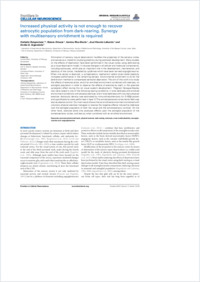Increased physical activity is not enough to recover astrocytic population from dark-rearing. Synergy with multisensory enrichment is required
- Bengoetxea, Harkaitz Laboratory of Experimental Neuroscience, Department of Neuroscience, Faculty of Medicine and Odontology, University of the Basque Country, Leioa, Spain
- Ortuzar, Naiara Laboratory of Experimental Neuroscience, Department of Neuroscience, Faculty of Medicine and Odontology, University of the Basque Country, Leioa, Spain
- Rico-Barrio, Irantzu Laboratory of Experimental Neuroscience, Department of Neuroscience, Faculty of Medicine and Odontology, University of the Basque Country, Leioa, Spain
- Lafuente, José Vicente Laboratory of Experimental Neuroscience, Department of Neuroscience, Faculty of Medicine and Odontology, University of the Basque Country, Leioa, Spain
- Argandoña, Enrike G. Unit of Anatomy, Department of Medicine, University of Fribourg, Switzerland
-
2013
Published in:
- Frontiers in Cellular Neuroscience. - 2013, vol. 7, p. 170
environmental enrichment
physical exercise
dark-rearing
astrocyte
cross-modal plasticity
neurogliovascular unit
angioglioneurins
English
Elimination of sensory inputs (deprivation) modifies the properties of the sensory cortex and serves as a model for studying plasticity during postnatal development. Many studies on the effects of deprivation have been performed in the visual cortex using dark-rearing as a visual deprivation model. It induces changes in all cellular and molecular components, including astrocytes, which play an important role in the development, maintenance, and plasticity of the cortex, mediated by cytokines which have been termed angioglioneurins. When one sense is deprived, a compensatory mechanism called cross-modal plasticity increases performance in the remaining senses. Environmental enrichment is so far the best-known method to compensate sensorial deprivation. The aim of this work is to study the effects of exercise alone, and of an enriched environment combined with exercise, on astroglial population in order to observe the effects of exercise by itself, or the potential synergistic effect during the rat visual system development. Pregnant Sprague-Dawley rats were raised in one of the following rearing conditions: in total darkness and enriched environment conditions with physical exercise, and in total darkness with voluntary physical exercise. Astrocytic density was estimated by immunohistochemistry for S-100β protein and quantifications were performed in layer IV. The somatosensorial cortex barrel field was also studied as control. Our main result shows that an enriched environment combined with voluntary physical exercise manages to reverse the negative effects induced by darkness over the astroglial population of both the visual and the somatosensory cortices. On the other hand, exercise alone only produces effects upon the astroglial population of the somatosensory cortex, and less so when combined with an enriched environment.
- Faculty
- Faculté des sciences et de médecine
- Department
- Département de Médecine
- Language
-
- English
- Classification
- Biological sciences
- License
- License undefined
- Identifiers
-
- RERO DOC 205532
- DOI 10.3389/fncel.2013.00170
- Persistent URL
- https://folia.unifr.ch/unifr/documents/303284
Statistics
Document views: 62
File downloads:
- arg_ipa.pdf: 123
